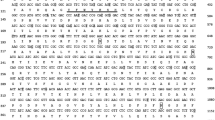Abstract
Four distinct laccase genes,lcc1, lcc2, lcc3 andlcc4, have been identified in the fungusRhizoctonia solani. Both cDNA and genomic copies of these genes were isolated and characterized. Hybridization analyses indicate that each of the four laccase genes is present in a single copy in the genome. TheR. solani laccases can be divided into two groups based on their protein size, intron/exon organization, and transcriptional regulation. Three of these enzymes have been expressed in the fungusAspergillus oryzae. Two of the recombinant laccases, r-lccl and r-lcc4, as well as the native lcc4 enzyme were purified and characterized. The purified proteins are homodimeric, comprised of two subunits of approximately 66 kDa for lcc4 and 50–100 kDa for the recombinant lccl protein. These laccases have spectral properties that are consistent with other blue copper proteins. With syringaldazine as a substrate, lcc4 has optimal activity at pH 7, whereas lcc1 has optimal activity at pH 6.
Similar content being viewed by others
References
Aramayo R and Timberlake WE (1990) Sequence and molecular structure of theAspergillus nidulans yA (laccase I) gene. Nucleic Acids Res 18:3415.
Blaich R, Esser K (1975) Function of enzymes in wood destroying fungi. II. Multiple forms of laccase in white rot fungi. Arch Microbiol 103:271–277
Bollag J-M, Leonowicz A (1984) Comparative studies of extracellular fungal laccases. Appl Environ Microbiol 48:849–854
Bollag J-M, Sjoblad RD, Liu S-Y (1979) Characterization of an enzyme fromRhizoctonia praticola which polymerizes phenolic compounds. Can J Microbiol, 25:229–233.
Bauer B, Rupe CO (1971) Use of syringaldazine in a photometric method for estimating ‘free” chlorine in water. Anal Chem 43:421–425.
Childs RE, Bardsley WG (1975) The steady-state kinetics of peroxidase with 2,2′-azino-di-(3-ethylbenzthiazoline-6-sulphonic acid) as chromogen. Biochem J 145:93–103
Choi GH, Larson, TG Nuss DL (1992) Molecular analysis of the laccase gene from the chestnut blight fungus and selective suppression of its expression in an isogenic hypovirulent strain. Mol Plant-Microbe Inter 5:119–128.
Christensen T, Woeldike H, Boel E, Mortensen SB, Hjortshoej K, Thim L, Hansen MT (1988) High-level expression of recombinant genes inAspergillus oryzae. Bio/Technol 6:1419–1422
Coll PM, Tabernero C, Santamaria R, Perez P (1993) Characterization and structural analysis of the laccase I gene from the newly isolated ligninolytic basidiomycete PM1 (CECT 2971). Appl Environ Microbiol 59:4129–4135.
Felsenfeld G (1959) The determinate of cuprous ion in copperproteins. Arch Biochem Biophys 87:247–251.
Germann UA, Lerch K (1986) Isolation and partial nucleotide sequence of the laccase gene fromNeurospora crassa: amino-acid sequence homology of the protein to human ceruloplasmin. Proc Natl Acad Sci USA 83:8854–8858.
Germann UA, Muller G, Hunziker PE, Lerch K (1988) Characterization of two allelic forms ofNeurospora crassa laccase; aminoand carboxyl-terminal processing of a precursor. J Biol Chem 263:885–896
Gomi K, Kitamoto K, Kumagai C (1992) Transformation of the industrial strain ofAspergillus oryzae with the homologous amdS gene as a dominant selectable marker. J Ferment Bioeng, 74:389–391
Kobata A (1992) Structures and functions of the sugar chains of glycoproteins. Eur J Biochem 290:483–501
Kofod LV, Kauppinen S, Christgau S, Andersen LN, Heldt-Hansen HP, Dorreich K, Dalboge H (1994) Cloning and characterization of two structurally and functionally divergent rhamnogalacturonases fromAspergillus aculeatus. J Biol Chem 269:29182–29189
Kojima Y, Tsukuda Y, Kawai Y, Tsukamoto A, Sugiura J, Sakaino M, and Kita Y (1990) Cloning, sequence analysis, and expression of ligninolytic phenoloxidase genes of the white-rot basidiomyceteCoriolus hirsutus. J Biol Chem 265:15224–15230
Leonowicz A, Trojanowski J, Orlicz B (1978) Induction of laccase inBasidiomycetes: apparent activity of the inducible and constitutive forms of the enzyme with phenolic substrates. Acta Biochim Pol 25:369–377
Marbach I, Harel E, and Mayer AM, (1983) Inducer and culture medium-dependent properties of extracellular laccase fromBotrytis cinerea. Phytochemistry, 22:1535–1538.
Marbach I, Harel E, Mayer AM (1984) Molecular properties of extracellularBotrytis cinerea laccase. Phytochemistry 23:2713–2717
Mayer AM (1987) Polyphenol oxidases in plants-recent progress. Phytochemistry 26:11–20
Messerschmidt A, Huber R, (1990) The blue oxidases, ascorbate oxidase, laccase and ceruloplasmin. Eur J Biochem, 187:341–352
Mosbach R (1962) Purification and some properties of laccase fromPolyporus versicolor. Biochim Biophys Acta 73:204–212
Nakamura T (1958) Purification and physicochemical properties of laccase. Biochim Biophys Acta 30:44–52
Perlman D, Halvorson HO (1983) A putative signal peptidase recognition site and sequence in eukaryotic and prokaryotic signal peptides. J Mol Biol 167:391–409
Perry CR, Smith M, Britnell CH, Wood DA, Thurston CF (1993) Identification of two laccase genes in the cultivated mushroomAgaricus bisporus. J Gen Microbiol, 139:1209–1218
Rehman AU, Thurston CF (1992) Purification of laccase I fromArmillaria mellea. J Gen Microl 138:1251–1257
Reinhammar BRM (1972) Oxidation-reduction potentials of the electron acceptors in laccases and stellacyanin. Biochim Biophys Acta 275:245–259
Saloheimo, M, Niku-Paavola M-L, Knowles JKC (1991) Isolation and structural analysis of the laccase gene from the lignindegrading fungusPhlebia radiata J Gen Microbiol, 137:1537–1544
Sambrook J, Fritsch EF, Maniatis T (1989) Molecular cloning. a laboratory manual, 2nd en. Cold Spring Harbor Laboratory, Cold Spring Harbor, New York
Shuttleworth KL, Postie L, Bollag J-M (1986) Production of induced laccase by the fungusRhizoctonia praticola. Can J Microbiol 32:867–870
Solomon EI, Baldwin MJ, Lowery MD (1992) Electronic structures of active sites in copper proteins: contributions to reactivity. Chem Rev 92:521–542
Hazel HB van den, Kielland-Brandt MC, Winther JR (1992) Autoactivation of proteinase A initiates activation of yeast vaculoar zymogens. Eur J Biochem 207:277–283
Heijne G von (1986) A new method for predicting signal sequence cleavage sites. Nucleic Acids Res 14:4683–4690
Xu F, Shin W, Brown SH, Wahleithner JA, Sundaram UM, Solomon EI (1995) A study of a series of recombinant fungal laccases and bilirubin oxidase that exhibit significant differences in redox potential, substrate specificity, and stability. Biochim Biophys Acta (in press)
Yelton M M, Hamer JE, Timberlake WE (1984) Transformation ofAspergillus nidulans by using atrpC plasmid. Proc Natl Acad Sci USA 81:1470–1474
Author information
Authors and Affiliations
Additional information
Communicated by D.R. Wolstenholme
Rights and permissions
About this article
Cite this article
Wahleithner, J.A., Xu, F., Brown, K.M. et al. The identification and characterization of four laccases from the plant pathogenic fungusRhizoctonia solani . Curr Genet 29, 395–403 (1996). https://doi.org/10.1007/BF02208621
Received:
Issue Date:
DOI: https://doi.org/10.1007/BF02208621




